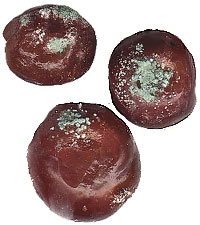(SOURCE: NCBI database)
KINGDOM: Fungi
DIVISION: Ascomycota
CLASS: Eurotiomycetes
ORDER: Eurotiales

The grapes at the left were stored in a refrigerator for so long that they got moldy. The mold is a species of the genus Penicillium, the same genus from which the powerful antibiotic penicillin is derived. If you ever opened an old jar of jelly or jam and its surface was covered with a greenish mat, that was probably a Penicillium species, too.
Species in the order Eurotiales, of which Penicillium is a member, often are known as green and blue molds. As of 2021 the order embraces three families, 49 genera and 928 species. In human lives, the main molds in that order encountered, or at least noticed, belong to the genera Penicillium and Aspergillus. Neither of those genera are dangerous to people enjoying normal health, though they can cause problems for those with weakened immune systems.
Penicillium species, of which over 300 are recognized, constitute a major part of the natural environment, especially in cool and moderate climates. They're abundant in the soil and anyplace where organic material is available. In human lives, except for those using the antibiotic penicillin, Penicillium species are most notable for causing food spoilage. Many produce highly toxic chemicals called mycotoxins.
Aspergillus species, of which "a few hundred" are recognized, often appear where you'd not think there's enough nutrients available to support them, such as on damp walls, where they're a major component of mildew, plus they turn up in bathrooms, on window frames and occur by the millions in pillows.